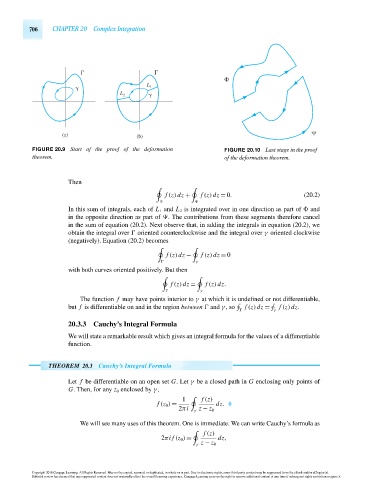Page 726 - Advanced_Engineering_Mathematics o'neil
P. 726
706 CHAPTER 20 Complex Integration
L
1
L 2
(a) (b)
FIGURE 20.9 Start of the proof of the deformation FIGURE 20.10 Last stage in the proof
theorem. of the deformation theorem.
Then
f (z)dz + f (z)dz = 0. (20.2)
In this sum of integrals, each of L 1 and L 2 is integrated over in one direction as part of and
in the opposite direction as part of . The contributions from these segments therefore cancel
in the sum of equation (20.2). Next observe that, in adding the integrals in equation (20.2), we
obtain the integral over oriented counterclockwise and the integral over γ oriented clockwise
(negatively). Equation (20.2) becomes
f (z)dz − f (z)dz = 0
γ
with both curves oriented positively. But then
f (z)dz = f (z)dz.
γ
The function f may have points interior to γ at which it is undefined or not differentiable,
but f is differentiable on and in the region between and γ ,so f (z)dz = f (z)dz.
γ
20.3.3 Cauchy’s Integral Formula
We will state a remarkable result which gives an integral formula for the values of a differentiable
function.
THEOREM 20.3 Cauchy’s Integral Formula
Let f be differentiable on an open set G.Let γ be a closed path in G enclosing only points of
G. Then, for any z 0 enclosed by γ ,
1 f (z)
f (z 0 ) = dz.
2πi γ z − z 0
We will see many uses of this theorem. One is immediate. We can write Cauchy’s formula as
f (z)
2πif (z 0 ) = dz,
γ z − z 0
Copyright 2010 Cengage Learning. All Rights Reserved. May not be copied, scanned, or duplicated, in whole or in part. Due to electronic rights, some third party content may be suppressed from the eBook and/or eChapter(s).
Editorial review has deemed that any suppressed content does not materially affect the overall learning experience. Cengage Learning reserves the right to remove additional content at any time if subsequent rights restrictions require it.
October 14, 2010 15:32 THM/NEIL Page-706 27410_20_ch20_p695-714

